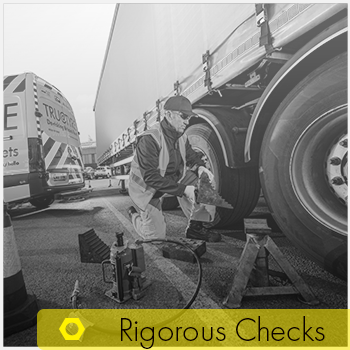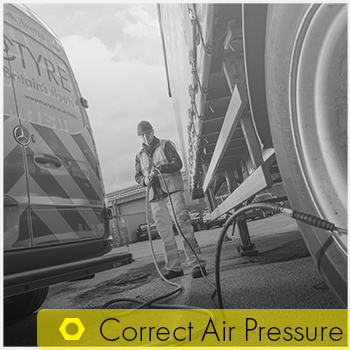Truck tyre inspections: The foundations of a safe fleet

Introduction - The need for tyre safety
With more than half a million trucks on Britain’s roads, our industry has a unique duty to do its bit for road safety. That is why Tructyre are focused on one simple goal - to de-risk Britain's fleets.
According to the 2020 publication entitled 'Guide to Tyre Management and Maintenance on Heavy Vehicles’, written by Kevin Rooney and Sarah Bell on behalf of the traffic commissioners for Great Britain;
“the condition of tyres has overtaken braking systems as the most common defect found on heavy goods vehicles and trailers at the roadside. Tyres also vie for the top spot on bus and coach checks. Operators must establish an appropriate system of preventative maintenance inspections and driver daily walk round checks.”
The Tructyre Approach
Liam Gorman, Technical Services Manager for Tructyre, says “With commercial tyres, it’s all about the frequency and professionalism of the tyre inspection. A now and again quick look doesn’t cut it.”
Tructyre’s heavy commercial vehicle tyre survey is an exercise in protecting the fleet from risk.
We will identify the precise time when a service to extend the life of the tyre and the operating safety of the truck, trailer, bus or coach should be deployed.
And we will optimise fleet uptime and increase tyre life, whilst reducing vehicle emissions and the chance of mission-failure.
When Tructyre is part of the operator’s tyre management system it will uncover and resolve threats to the safety of the fleet and other road users.

The dangers of an inconsistent tyre inspection regime
An inconsistent tyre inspection regime will lead to prematurely scrapped tyres with the fleet exposed to risks that should be efficiently and economically mitigated.
Tructyre has hundreds of well-trained and competent tyre fitters across the country and a key part of their training and role is knowing what to look for during a tyre survey and establishing the correct response.
The inspection of the fleet's tyres informs the correct course of action to be taken in the interests of the operator’s tyre policy, uptime, budget, and safety.
The tread is the interface between the vehicle and the road, so the visual inspection of tread and the physical measurement of the tyre’s tread depth is an important element of the tyre inspection.

Tread - It's about more than tread depth
- Is there sufficient tread to promote the safe operation of the vehicle in all weather conditions?
- Is it the right time to remove, retread, or regroove?
- Is there dangerously asymmetric wear?
- Is the general condition of the tread satisfactory?
The tread is just part of the equation; the rest of the tyre, including the shoulder, sidewall, and bead area, is just as important.
- Are there any cuts or splits, cracks, or bulges?
- Has scuffing damaged the sidewall which might lead to a tyre failure?
- Is there evidence that age, operating style, or incorrect inflation has deteriorated the condition of the tyres.
As well as the tyre issues shown above, the tyre inspection can uncover many small, seemingly inconsequential defects that, if left unchecked, can have a big economic or safety effect.
Tructyre’s robust inspection regime will establish such issues and deal with them in a best-practice manner as well as promoting best-practice for tyre maintenance throughout the fleet.
Correct tyre inflation: the only acceptable best case
While the visual condition of a tyre can be assessed by the trained eye, tyre pressure can never be correctly measured by a visual check.
Liam says, “Truck tyres, like any other tyre, only wear correctly and operate safely when inflated to the correct pressure. If the tyres aren’t safe, the vehicle isn't safe.
“We talk about incorrect inflation, not just under-inflation. The load, operating conditions, and tyre temperature will vary throughout a day and the tyres need to be in a condition to support a fully loaded or unloaded vehicle in varied operating conditions.
“There is no ‘at best’ scenario with incorrect inflation – the load will not be appropriately supported. This is never safe, and the tyre will never fulfill its maximum service life”.

Truck Tyre Inspections and Safety - final thoughts.
An important benefit of the tyre inspection is monetary. With the replacement tyre cost for a 6 wheeled truck in excess of £1,000 -more for Michelin, Continental, or Hankook branded truck tyres - the inspection is a small outlay that can have a big effect on delaying the significant expenditure of tyre replacement as long as safely possible.
For fleets running a budget tyre policy the cost of tyre replacement is smaller, but the risks presented are the same. Operators running budget truck tyres benefit from pro-active tyre maintenance.
Tyre maintenance is not a nice-to-have. Rooney and Bell, writing on behalf of the traffic commissioners of Great Britain note, “A robust tyre management system is essential for any professional vehicle operator.” This is why Tructyre designed its tyre management systems to protect fleets and give the operator the intelligence to make informed tyre decisions.
Whether the fleet is operating trucks and trailers or buses and coaches, the core risks are similar and well established – safety and economic. Two sides of the same coin.
The question is, has your operation done all it can to de-risk the fleet?
- Well run fleets benefit from a tyre management system.
- The benefits are spending less money on tyres and enhancing safety.
- The fleet will also benefit from reduced fuel burn and lower emissions.
- Tructyre's tyre management options are an excellent way to de-risk your fleet.
